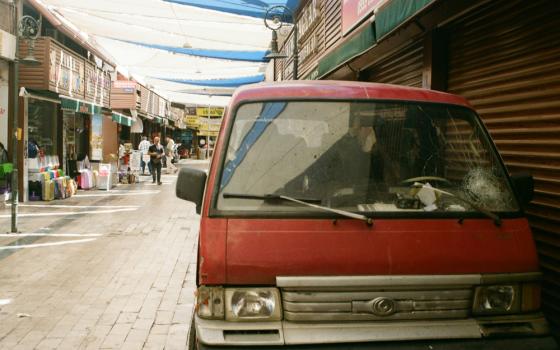On the first day of Creation, God said, “Let there be light,” and there was light. Now, every Monday night, a group of people, many disadvantaged youth, gather in Chestnut Ridge, West Virginia and they make light for even more disadvantaged families in Africa.
The “Genesis kits” have an interesting history. Ruston Seaman, a devout Christian who belongs to a non-denominational church, had met up with John Prusa, a Czech exile with a degree in electrical engineering. In 2009, they formed New Vision Renewable Energy. “We started making solar panels in our own community for families who needed help paying for utilities,” Seaman told me. They discovered that those old, heavy glass tub doors could be modified to make a solar panel. Who knew?
In March 2012, Seaman traveled to Kenya. “We had a woman, Cindy Kelley, who felt called to be a missionary,” he recalls. “It was the first time in the history of our church that we had sent forth a missionary. I traveled with her to help get her established.” They brought along a solar cooker. This provoked a conversation with one of the men in the village where Kelley would be working and living. “We could make these if we had shiny paper,” the man said to Seaman. Four months later at a solar trade show, Seaman saw a display with shiny paper at a 3-M display. He researched who at 3-m he needed to talk to, called and asked, “Have you ever thought about how your shiny paper could help the poorest people in the world?” A short time later, 3-M delivered reams of shiny paper to Chestnut Ridge. “It was a game changer.”
The group tried to figure out ways to make a kit that would permit a family in Kenya to collect solar power during the day sufficient to light their home in the evening for five hours. They needed something with structural support. “We happened to be at the end of the election cycle,” Seaman tells me. “All these political yards signs, for Romney, for Obama, for local candidates, were out on people’s lawns. They worked perfectly – they are lightweight and they were not destroyed by rain.” Shortly after, they started making the kits.
This past summer, the Monday night group made 300 Genesis kits and sent them to Kenya. Seaman cites studies that indicate electricity in a home leads to higher educational advancement as well as less stress on a family. The New York Times ran a photo of children in Africa, squatting underneath street lights to do their homework. Seaman shared the photo with the kids. “This helps our kids, who are at the bottom of the food chain in our country, realize how much we have and how they can help those with less.”
Christian Albacan is 13 years old. He worked at the groups “Innovation Station” making the kits for two weeks this summer and now is a regular at the Monday night sessions. “I’m happy to know we are helping kids in need, who don’t have all the electricity we have here in the big U.S.,” he told me. Thomas Villors, 16, stumbled on the project. “First it started as a thing where we’d go to the park and play with some kids who did this, then we went to their church, ate with them, and they gave us a briefing about what to do, how to make the kits. We go every week. It’s really fun,” says Villors. He also notes that in addition to helping people with less, “I now have a new skill I can use to help other people. I wouldn’t have that if I had not joined up.”
It occurred to the group that they wanted to gain more notoriety for their work, to spread the message that something so small as five hours of electricity can make a huge change in other people’s lives. They decided to send one of the kits to someone famous who could be an ambassador for their work. President Obama was nominated, as was Shaquille O’Neal. But, the kids voted to select Pope Francis. Yesterday, Seaman sent one of the kits to the Apostolic Nuncio in Washington with the request that he send it on to the pope. “He [the pope] right now, he’s one of the most popular people in the world and maybe if he sees what we are doing, he can get word out about our technology to the rest of the world,” says Albacan.
“Our theology doesn’t require a lot of conversation,” says Seaman. “The theology of light is pretty obvious.” His comments are strewn with references to God’s goodness, mixed in with technological words he needs to explain to me. But, it is the accessibility of his project, and the beauty of the story – a group of disadvantaged children helping yet more disadvantaged children – that makes this project just the kind of thing that might catch Pope Francis’ attention. Who knows? A light bulb may go off in his head and his heart. One went off in mine: If Pope Francis can capture the imagination of children, most of them not even Catholic, in West Virginia, the potential for the Body of Christ to make a real difference in the lives of the most poor people on the planet will be the best kind of evangelization in the 21st century.




